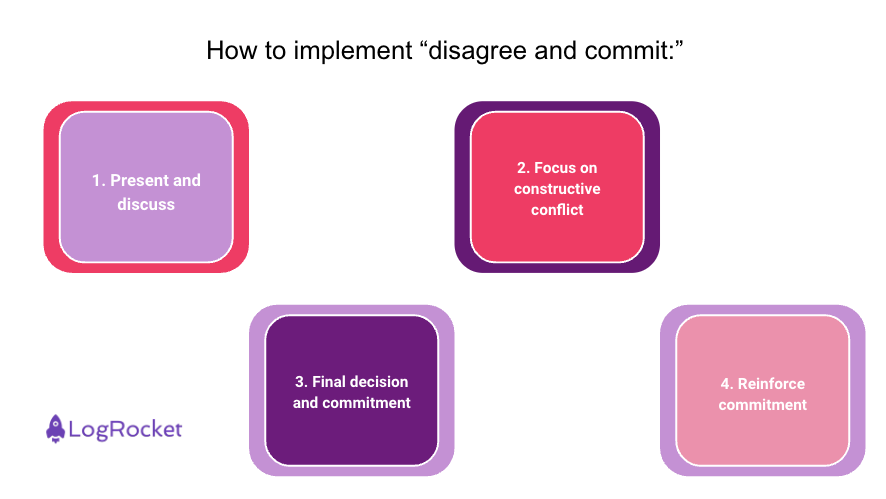The phrase “disagree and commit” is a management principle that encourages team members to voice their opinions during the decision-making process. This helps make sure that less vocal members of your team can contribute and allows you to make more informed decisions.

After you agree on a final decision, the principle then requires team members to commit to it, even if they disagree. The “disagree and commit principle” helps foster open communication, share diverse viewpoints, critically evaluate ideas, and ensure team unity.
Keep reading to learn more about how to implement it, keys to its success, and a real-world example.
The primary purpose of embracing “disagree and commit” is to ensure that you have a way to reach a decision and create an action plan within the course of a meeting. If you wait for universal consensus, you might lose valuable development time that could put you behind your competitors.
There’s also no guarantee that you can convince all stakeholders to agree on a project. This phenomenon is known as the consensus trap and it leads to inaction.
“Disagree and commit” encourages team members to speak up when they think something is wrong or missing. It fosters a culture where differing and innovative ideas are valued. However, the caveat is that the team is expected to fully commit to an idea even if they aren’t fully convinced of its value.
Implementing the “disagree and commit” strategy involves maintaining team unity while creating a culture to express differing opinions. Your team should know they have two responsibilities:
Here is a structured approach to implement the “disagree and commit” strategy effectively:

Create a space for team members to share counterarguments openly. People may associate disagreements with negativity. Counter this preconceived notion by rewarding people for pointing out possible problems and issues. Team members should feel like they can speak without judgment.
It’s not enough for a team member to simply say they do or don’t like an idea. They should provide data to support their claim, including what outcomes might happen, and alternative ideas.
You can help foster constructive conflict by asking team members to provide context and rationale for their ideas. The process can help identify potential solutions.
This is a crucial step for a successful “disagree and commit” strategy. If the conversations aren’t constructive, you won’t have a productive decision-making process.
After all team members have shared their constructive criticism, the decision-maker will decide on the best path forward. Transparency is important, so you want to share with your team why you chose this particular path. You’ll also want to discuss how it fits with larger goals. After the final decision, team members are expected to support it and commit to seeing it through.
Encourage your team to meet the overall objectives of the final decision. Everyone is responsible for their work, and you want to highlight successful executions.
As the work begins, you may find it beneficial to establish a well-defined escalation path. The procedure will involve the final decision-maker, and they can resolve problems quickly. It can help minimize delays or unfruitful debates that are at an impasse.
Several key strategies are necessary to implement the “disagree and commit” principle. Here are a few to consider:
The digital communications platform Slack ran into a UI problem and realized people were unaware of new features because they weren’t easily accessible. The overall UI design was no longer functional and easy to use.
To find a solution, Slack gathered designers, engineers, researchers, and product managers for intensive discussions. Designers created prototypes with the aim of sparking debate with stakeholders. Engineers and product leaders were allowed to discard impractical ideas and find creative solutions to challenges.
Clear communication channels were set, including feedback workflows, user assessments, and ongoing research workstreams. The framework helped with everything from small design questions to addressing cross-functional challenges.
Slack dedicated itself to many principles behind “disagree and commit”. It ensured all teams were part of the discussion and could share their expertise. Slack also committed to its conviction of a complete design overhaul and ensured regular communication to resolve roadblocks.
In the end, Slack’s redesign properly showcased its various features and reinforced product cohesion.
There are a few challenges that you face when implementing the “disagree and commit” strategy such as:
There are solutions to these hurdles. The most important solution is to ensure a safe environment for dissenting opinions. Setting ground rules for communication is crucial for everyone to be heard and feel respected. Even if an idea isn’t chosen, team members need to know their opinion is valued.
You should also prioritize providing communication channels and escalation paths. It makes it easier for team members to find solutions.
“Disagree and commit” helps teams openly share their expertise and unique perspectives. Hearing their opinion is crucial for making a fully informed product decision. “Disagree and commit” can create an environment that is open and safe to share thoughts and alternative solutions. The principle can help support a collaborative and innovative workplace.
You can encourage the “disagree and commit” principle by rewarding team members who share their opinions. It’s also crucial to demonstrate your conviction by committing to the final decision and actively participating in discussions.
Featured image source: IconScout

LogRocket identifies friction points in the user experience so you can make informed decisions about product and design changes that must happen to hit your goals.
With LogRocket, you can understand the scope of the issues affecting your product and prioritize the changes that need to be made. LogRocket simplifies workflows by allowing Engineering, Product, UX, and Design teams to work from the same data as you, eliminating any confusion about what needs to be done.
Get your teams on the same page — try LogRocket today.

A practical framework for PMs to use AI in ideation without sacrificing judgment, strategy, or decision quality.

A practical five minute revenue estimation method to help product managers compare ideas, drop low impact features, and prioritize smarter.

A practical guide for PMs who want to stop being bottlenecks, delegate smarter, and lead teams effectively with a clear ownership framework.

Stop letting unreliable data block features. Treat data as inventory to track quality, ownership, and ship with confidence.